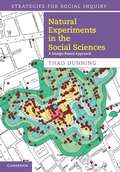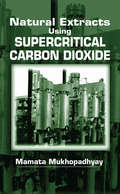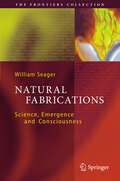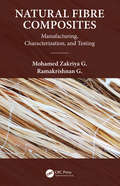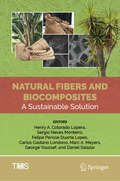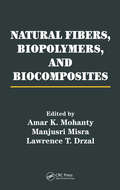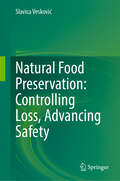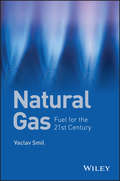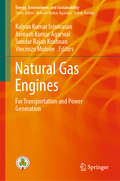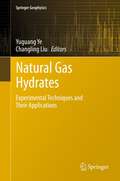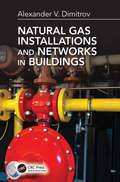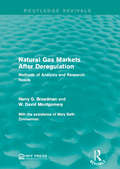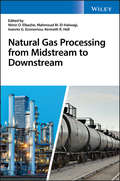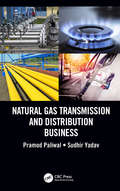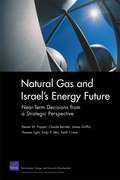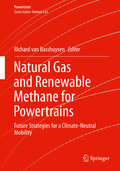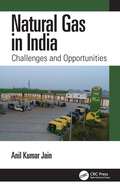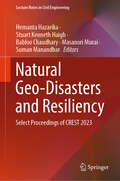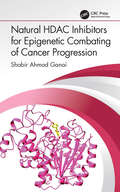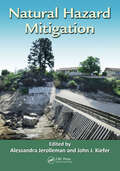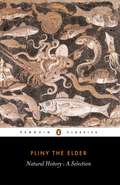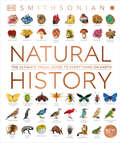- Table View
- List View
Natural Experiments in the Social Sciences
by Thad DunningThis unique book is the first comprehensive guide to the discovery, analysis and evaluation of natural experiments – an increasingly popular methodology in the social sciences. Thad Dunning provides an introduction to key issues in causal inference, including model specification, and emphasizes the importance of strong research design over complex statistical analysis. Surveying many examples of standard natural experiments, regression-discontinuity designs and instrumental-variables designs, Dunning highlights both the strengths and potential weaknesses of these methods, aiding researchers in better harnessing the promise of natural experiments while avoiding the pitfalls. Dunning also demonstrates the contribution of qualitative methods to natural experiments and proposes new ways to integrate qualitative and quantitative methods. Chapters complete with exercises and suggestions for further reading, and appendices covering specialized topics such as cluster-randomized natural experiments make this an ideal book for students as well as a valuable teaching tool.
Natural Extracts Using Supercritical Carbon Dioxide
by Mamata MukhopadhyaySynthesizing research from a wide variety of sources, this work offers a convenient guide to a clean, safe, inexpensive, non-toxic, non-polluting solvent that performs better than most conventional solvents. Natural Extracts Using Supercritical Carbon Dioxide reviews recent development in the technology and its applications to the food, flavor, fra
Natural Fabrications
by William SeagerThe spectacular success of the scientific enterprise over the last four hundred years has led to the promise of an all encompassing vision of the natural world. In this elegant picture, everything we observe is based upon just a few fundamental processes and entities. The almost infinite variety and complexity of the world is thus the product of emergence. But the concept of emergence is fraught with controversy and confusion. This book ponders the question of how emergence should be understood within the scientific picture, and whether a complete vision of the world can be attained that includes consciousness.
Natural Fiber Composites: Manufacturing, Characterization and Testing
by Mohamed Zakriya G Ramakrishnan GovindanThis book covers the use of accessible natural fibers towards the requirement and compatibility of industrial sustainability. Using natural characteristics of composites through technology and techniques, the inherent qualities of natural fibers are discussed in relation to the design of experiments. This book also elaborates on the durability of composites subjected to environmental conditions, biodegradability, environmental issues, product life cycle assessment and testing methods. Offers detailed coverage of functional aspects of natural fiber composites along with applications Discusses natural fiber inherent character based composite formation techniques Reviews micro-mechanical and macro-mechanical properties and functional use of natural fiber reinforced composites Content based on functional requirements selection and process consideration Discusses product life cycle assessment and recycling techniques This book is aimed at researchers, students, industrialists, and fabricators of composites.
Natural Fibers and Biocomposites: A Sustainable Solution (The Minerals, Metals & Materials Series)
by Sergio Neves Monteiro Marc A. Meyers Henry A. Colorado Lopera Felipe Perisse Duarte Lopes Carlos Castano Londono George Youssef Daniel SalazarNatural fibers' abundance, excellent properties, biodegradability, and low cost make this renewable resource a green alternative to synthetic fibers for composite material reinforcement. The need to create sustainable solutions has promoted applications in sports, transportation, armor, medicine, infrastructure, construction and building materials, and architecture. This collection promotes the use of natural materials and their composites as a possible strategy to increase environmental sustainability, as well as to study materials fundamentals for new applications. Topics include but are not limited to: • Properties and fundamentals of natural fibers • Surface modifications to improve properties • Biocomposite materials and potential contributions to sustainability • Durability, dynamic behavior, adhesion, impact response, mechanical, thermal, and other properties related to natural materials and their composites
Natural Fibers, Biopolymers, and Biocomposites
by Manjusri Misra Amar K. Mohanty Lawrence T. DrzalNatural/Biofiber composites are emerging as a viable alternative to glass fiber composites, particularly in automotive, packaging, building, and consumer product industries, and becoming one of the fastest growing additives for thermoplastics. Natural Fibers, Biopolymers, and Biocomposites provides a clear understanding of the present state
Natural Flavours, Fragrances, and Perfumes: Chemistry, Production, and Sensory Approach
by Sabu Thomas Sreeraj Gopi Nimisha Pulikkal Sukumaran Joby JacobNatural Flavours, Fragrances, and Perfumes Explore this one-stop resource on every relevant aspect of natural flavors and fragrances The use of sensory science has the potential to give scientists, researchers, and industry specialists a way to overcome the challenges in nutraceuticals and, more generally, in the functional food industry. Flavor and fragrance have the potential to significantly influence consumer satisfaction with products and its success in the marketplace. In order to effectively produce and optimize a customer’s experience in both food and household products, it is essential to have a strong understanding of the fundamentals of chemistry and physicochemical processes. Natural Flavours, Fragrances and Perfumes offers a comprehensive look at the sensory sciences necessary to produce the most appealing olfactory responses derived from natural resources for consumers – from the analysis and biomolecular aspects of natural products to the processing and isolation of desired products, from the perceptual properties to regulatory aspects. Specifically, the book presents novel approaches to the processes involved in producing plant-derived functional products by examining how characteristic flavors arise due to complex interactions between hundreds of molecules, as well as studying the physiological variables that affect flavor perception. Natural Flavours, Fragrances, and Perfumes readers will also find: Insights into the identification and characterization of plant volatiles, as well as chromatography techniques for sensory fingerprints Chapters devoted to biosynthesis and metabolic pathways for the development of household products composed of organic materials Additional chapters on the advances in flavor science, on technological advances in the effective delivery of flavor, and challenges in the retention and release of flavor Natural Flavours, Fragrances, and Perfumes is a useful reference for chemists of all kinds, food scientists, biotechnologists, and perfumers, as well as those studying in these fields.
Natural Food Preservation: Controlling Loss, Advancing Safety
by Slavica VeskovicControlling food spoilage is critical not only to maintaining public health, but also to minimizing food loss, which in turn has broad impacts on the economy and the environment. Consumers today, concerned with both human and ecological health, are adamant that the elimination of risk for foodborne disease need not come at the cost of nutritional quality or ecological considerations. Moreover, a large factor towards the continued threat of foodborne illness is the fact that the responsible bacteria are increasingly resistant to conventional antibiotics. Considering that nature provides abundant antimicrobial compounds, it is salutary to assess the role that these compounds can play in fighting foodborne pathogens. As a result of these demands and considerations, natural antimicrobials are beginning to gain ground over their synthetic counterparts in industrial food safety processes. The success of these antimicrobial agents in individual settings has demonstrated that safe food doesnot have to mean highly processed or less sensorially satisfying food. Natural Preservation: Safety, Losses and Protection will discuss the economic and ecological benefits of a food industry moving away from dependence on synthetic chemicals and preservatives, and illustrate the impact that the extension of shelf life for the minimization of food waste can have on food insecurity across the globe. Readers can expect an overview of safety that considers economic as well as ecological interests, and assesses each stage of the food processing chain for its role in improving the nutritional, physicochemical and sensory values of the product. This includes a discussion of lactic acid bacteria (LAB) and their secondary metabolic products, bacteriocins, and how their application to fermentation processes can expand the possibilities for natural approaches to food safety, with major implications for global health and ecology. This volume demonstrates the integral role bio-protectors can play in production processes, promoting their potential while also outlining the necessity for appropriate laboratory, industrial and medical evaluations to ensure their efficacy and win their approval by regulatory bodies. The perspectives offered will be valuable to researchers, policymakers and industry professionals with investments in building a more sustainable and more equitable food system.
Natural Gas
by Vaclav SmilNatural gas is the world's cleanest fossil fuel; it generates less air pollution and releases less CO2 per unit of useful energy than liquid fuels or coals. With its vast supplies of conventional resources and nonconventional stores, the extension of long-distance gas pipelines and the recent expansion of liquefied natural gas trade, a truly global market has been created for this clean fuel. Natural Gas: Fuel for the 21st Century discusses the place and prospects of natural gas in modern high-energy societies. Vaclav Smil presents a systematic survey of the qualities, origins, extraction, processing and transportation of natural gas, followed by a detailed appraisal of its many preferred, traditional and potential uses, and the recent emergence of the fuel as a globally traded commodity. The unfolding diversification of sources, particularly hydraulic fracturing, and the role of natural gas in national and global energy transitions are described. The book concludes with a discussion on the advantages, risks, benefits and costs of natural gas as a leading, if not dominant, fuel of the 21st century. This interdisciplinary text will be of interest to a wide readership concerned with global energy affairs including professionals and academics in energy and environmental science, policy makers, consultants and advisors with an interest in the rapidly-changing global energy industry.
Natural Gas Engines: For Transportation And Power Generation (Energy, Environment, and Sustainability)
by Avinash Kumar Agarwal Kalyan Kumar Srinivasan Sundar Rajan Krishnan Vincenzo MuloneThis book covers the various advanced reciprocating combustion engine technologies that utilize natural gas and alternative fuels for transportation and power generation applications. It is divided into three major sections consisting of both fundamental and applied technologies to identify (but not limited to) clean, high-efficiency opportunities with natural gas fueling that have been developed through experimental protocols, numerical and high-performance computational simulations, and zero-dimensional, multizone combustion simulations. Particular emphasis is placed on statutes to monitor fine particulate emissions from tailpipe of engines operating on natural gas and alternative fuels.
Natural Gas Hydrate - Arctic Ocean Deepwater Resource Potential
by Michael D. Max Arthur H. Johnson William P. DillonThe book is an up-to-date basic reference for natural gas hydrate (NGH) in the Arctic Ocean. Geographical, geological, environmental, energy, new technology, and regulatory matters are discussed. The book should be of interest to general readers and scientists and students as well as industry and government agencies concerned with energy and ocean management. NGH is a solid crystalline material that compresses gas by about a factor of about 164 during crystallization from natural gas (mainly methane) - rich pore waters over time. NGH displaces water and may form large concentrations in sediment pore space. Its formation introduces changes in the geotechnical character of host sediment that allows it to be distinguished by seismic and electric exploration methods. The chemical reaction that forms NGH from gas and water molecules is highly reversible, which allows controlled conversion of the NGH to its constituent gas and water. This can be achieved rapidly by one of a number of processes including heating, depressurization, inhibitor injection, dissolution, and molecular replacement. The produced gas has the potential to make NGH a valuable unconventional natural gas resource, and perhaps the largest on earth. Estimates for NGH distribution, concentration, economic targets, and volumes in the Arctic Ocean have been carried out by restricting the economic target to deepwater turbidite sands, which are also sediment hosts for more deeply buried conventional hydrocarbon deposits. Resource base estimates are based on NGH petroleum system analysis approach using industry-standard parameters along with analogs from three relatively well known examples (Nankai-Japan, Gulf of Mexico-United States, and Arctic permafrost hydrate). Drilling data has substantiated new geotechnical-level seismic analysis techniques for estimating not just the presence of NGH but prospect volumes. In addition to a volumetric estimate for NGH having economic potential, a sedimentary depositional model is proposed to aid exploration in the five different regions around the deep central Arctic Ocean basin. Related topics are also discussed. Transport and logistics for NGH may also be applicable for stranded conventional gas and oil deposits. Arising from a discussion of new technology and methodologies that could be applied to developing NGH, suggestions are made for the lowering of exploration and capital expenses that could make NGH competitive on a produced cost basis. The basis for the extraordinarily low environmental risk for exploration and production of NGH is discussed, especially with respect to the environmentally fragile Arctic region. It is suggested that because of the low environmental risk, special regulations could be written that would provide a framework for very low cost and safe development.
Natural Gas Hydrates
by Changling Liu Yuguang Ye"Natural Gas Hydrates: Experimental Techniques and Their Applications" attempts to broadly integrate the most recent knowledge in the fields of hydrate experimental techniques in the laboratory. The book examines various experimental techniques in order to provide useful parameters for gas hydrate exploration and exploitation. It provides experimental techniques for gas hydrates, including the detection techniques, the thermo-physical properties, permeability and mechanical properties, geochemical abnormalities, stability and dissociation kinetics, exploitation conditions, as well as modern measurement technologies etc. This book will be of interest to experimental scientists who engage in gas hydrate experiments in the laboratory, and is also intended as a reference work for students concerned with gas hydrate research. Yuguang Ye is a distinguished professor of Experimental Geology at Qingdao Institute of Marine Geology, China Geological Survey, China. Professor Changling Liu works at the Qingdao Institute of Marine Geology, China Geological Survey, China.
Natural Gas Installations and Networks in Buildings
by Alexander V. DimitrovThis book covers theoretical foundations of the Natural Gas (NG) installations and networks as a part of building logistic system, illustrated with digital examples. It describes the NG oxidation phenomena and appropriate energy converting devices used in the building’s energy centres and basic sizing principals of the related pipe networks. Further, it covers usage of NG devices including system for thermal comfort control, building ventilation, indoor air quality, visual comfort, food preparation and conservation, and hygiene maintenance system. A special attention is given to applications of the NG technological equipment, using gas-driven heat pumps, micro heat and power systems. Aimed at professionals and graduate students in the areas of HVAC, Plumbing, Architecture, Electricians, this book: Presents complex, innovative and systematical approach to NG installations in buildings. Reviews efficient and environmentally sustainable dementalization approach to building energy supply, using NGmHps v/s central energy supply systems. Explains pre-designating calculations of the gas piping networks. Illustrates structures, principals of operation and building project implementations of the modern GN energy converters and transformers as fuel cells (SOFC, MOFC, PEFC) and NG driven heat pumps. Discusses calculation methods derived from professional case studies.
Natural Gas Markets After Deregulation: Methods of Analysis and Research Needs (Routledge Revivals)
by Harry G. Broadman W. David MontgomeryOriginally published in 1983, Broadman and Montgomery present an agenda for further research into deregulated natural gas markets by relating natural gas production, transmission and distribution with the economic function of contracts and local distribution companies. This work raises fundamental issues that could arise with the deregulation of the natural gas industry and outlines analytical methods that could be used to predict any problems that might arise and possible changes to policy. This title is of interest to students of Environmental Studies and professionals.
Natural Gas Processing from Midstream to Downstream
by Mahmoud M. El-Halwagi Kenneth R. Hall Nimir O. Elbashir Ioannis G. EconomouA comprehensive review of the current status and challenges for natural gas and shale gas production, treatment and monetization technologies Natural Gas Processing from Midstream to Downstream presents an international perspective on the production and monetization of shale gas and natural gas. The authors review techno-economic assessments of the midstream and downstream natural gas processing technologies. Comprehensive in scope, the text offers insight into the current status and the challenges facing the advancement of the midstream natural gas treatments. Treatments covered include gas sweeting processes, sulfur recovery units, gas dehydration and natural gas pipeline transportation. The authors highlight the downstream processes including physical treatment and chemical conversion of both direct and indirect conversion. The book also contains an important overview of natural gas monetization processes and the potential for shale gas to play a role in the future of the energy market, specifically for the production of ultra-clean fuels and value-added chemicals. This vital resource: Provides fundamental chemical engineering aspects of natural gas technologies Covers topics related to upstream, midstream and downstream natural gas treatment and processing Contains well-integrated coverage of several technologies and processes for treatment and production of natural gas Highlights the economic factors and risks facing the monetization technologies Discusses supply chain, environmental and safety issues associated with the emerging shale gas industry Identifies future trends in educational and research opportunities, directions and emerging opportunities in natural gas monetization Includes contributions from leading researchers in academia and industry Written for Industrial scientists, academic researchers and government agencies working on developing and sustaining state-of-the-art technologies in gas and fuels production and processing, Natural Gas Processing from Midstream to Downstream provides a broad overview of the current status and challenges for natural gas production, treatment and monetization technologies.
Natural Gas Transmission and Distribution Business
by Pramod Paliwal Sudhir YadavThe natural gas business consists of two major aspects, sourcing and transportation, and distribution has been a growing area of interest to industry, government and academia. With the emphasis on promoting natural gas sector, there is an increasing need to have a well documented book that deals with the business issues, particularly the transportation and distribution of this sector, specifically aimed at petroleum engineers and professionals. This book fills this gap to provide structured material that deals with managerial and regulatory aspects with an applied technical perspective wherever needed.
Natural Gas and Israel's Energy Future
by Thomas Light Claude Berrebi James Griffin Steven W. Popper Endy Y. MinThis book discusses the opportunities and risks the government of Israel faces in shifting to a greater reliance on domestic and imported natural gas. By applying newly developed methods for strategic planning and decisionmaking under deep uncertainty, the analysis seeks to help the Israeli government engage in managed change by choosing robust strategies that minimize potential consequences of relying more heavily on natural gas.
Natural Gas and Renewable Methane for Powertrains
by Richard Van BasshuysenThis book focuses on natural gas and synthetic methane as contemporary and future energy sources. Following a historical overview, physical and chemical properties, occurrence, extraction, transportation and storage of natural gas are discussed. Sustainable production of natural gas and methane as well as production and storage of synthetic methane are scrutinized next. A substantial part of the book addresses construction of vehicles for natural and synthetic methane as well as large engines for industrial and maritime use. The last chapters present some perspectives on further uses of renewable liquid fuels as well as natural gas for industrial engines and gas power plants.
Natural Gas in India: Challenges and Opportunities
by Anil Kumar JainThis book provides a detailed discussion on India’s energy mix including descriptive use of the Shannon Wiener diversity index for numerically comparing India’s diversity in energy supply with other leading energy-consuming countries. The likely supply scenarios of both domestic and imported gas, and price competitiveness with competing fuels in differing consuming sectors, have also been presented. Overall, it covers energy systems, a comparison of the Indian natural gas economy with other countries and a scenario-based analysis of gas demand in India in 2030. Features: Presents a well-structured and robust thesis on the challenges and opportunities for natural gas in India’s energy future. Draws upon key insights, lessons and ways forward from the gas sector reform process. Addresses the energy transition scenario towards net zero. Includes comparative analysis of India’s diversity of commercial primary energy supply. Uses granular data and visual representations of the same to convey the key arguments. This book is aimed at oil and gas industry stakeholders including professionals, business executives, techno-managerial personnel and students in chemical engineering.
Natural Geo-Disasters and Resiliency: Select Proceedings of CREST 2023 (Lecture Notes in Civil Engineering #445)
by Hemanta Hazarika Stuart Kenneth Haigh Babloo Chaudhary Masanori Murai Suman ManandharThis book presents select proceedings of the 2nd International Conference on Construction Resources for Environmentally Sustainable Technologies (CREST 2023), and focuses on sustainability, promotion of new ideas and innovations in design, construction and maintenance of geotechnical structures with the aim of contributing towards climate change adaptation and disaster resiliency to meet the UN Sustainable Development Goals (SDGs). It presents latest research, information, technological advancement, practical challenges encountered, and solutions adopted in the field of geotechnical engineering for sustainable infrastructure towards climate change adaptation. This volume will be of interest to those in academia and industry alike.
Natural Grace: The Charm, Wonder, and Lessons of Pacific Northwest Animals and Plants
by William DietrichThis informative and engaging selection of natural history essays is adapted from articles published in the Seattle Times magazine, Pacific Northwest. A native Washingtonian, Dietrich has watched the Northwest double in population during his lifetime. Our rapidly changing view of nature is an underlying theme throughout his wide-ranging essays, as is the timely and essential question of how best to share and conserve the natural world that drew us to the region in the first place.
Natural HDAC Inhibitors for Epigenetic Combating of Cancer Progression
by Shabir Ahmad GanaiNatural HDAC Inhibitors for Epigenetic Combating of Cancer Progression deals only with HDAC inhibitors from natural origins including bacteria, fungi, marine organisms and, notably, from diverse plant sources. This book is unique in the sense that it is the only book that discusses wholly and solely HDAC inhibitors of natural origin in the context of cancer chemotherapy. Another peculiar feature of this book is that it debates futuristic nanotechnology approaches for escalating the aqueous solubility, cancer cell uptake, bioavailability and other favourable pharmacological parameters, including the cytotoxicity of natural HDAC inhibitors against cancer cells. The major features of this book encompass General compendium of HDAC inhibitors with deep emphasis on the toxicity issues of synthetic HDAC inhibitors Various groups of natural HDAC inhibitors, their representatives and premier sources Cyclic tetrapeptides of natural origin and their importance as cancer chemotherapeutic agents Hydroxamates and depsipeptides from natural sources and their promising role in cancer therapy Natural flavonoids, their HDAC inhibitory tendency and marvellous anticancer activity Non-flavonoid natural HDAC inhibitors and their pleasing cytotoxic effects towards cancer models Combined therapy involving natural flavonoids with other anticancer molecules for synergistic and additive benefits against cancer models Non-flavonoid HDAC inhibitors and conventional drugs in collaborative mode against aggressive malignancies Nanotechnology-based delivery of natural HDAC inhibitors for greater therapeutic efficacy over traditional combinatorial therapy This book is highly beneficial to university professors and research scholars working on epigenetic therapeutics in general, and natural HDAC inhibitors in particular. This book is equally important to medical oncologists, biochemistry as well as pharmacy candidates and students of master's and undergraduate level with a desire to do a doctorate on HDACs, natural HDAC inhibitors, HDAC inhibitor (natural)-based combinatorial chemotherapy and delivery of these inhibitors selectively to tumour sites through revolutionary nanotechnological tactics.
Natural Hazard Mitigation
by Alessandra Jerolleman John J. KieferOne of the four core phases of emergency management, hazard mitigation is essential for reducing disaster effects on human populations and making communities more resilient to the impacts of hazards. Presenting an up-to-date look at the changing nature of disasters, Natural Hazard Mitigation offers practical guidance on the implementation and selec
Natural History
by Pliny the ElderPliny's Natural History is an astonishingly ambitious work that ranges from astronomy to art and from geography to zoology. Mingling acute observation with often wild speculation, it offers a fascinating view of the world as it was understood in the first century AD, whether describing the danger of diving for sponges, the first water-clock, or the use of asses' milk to remove wrinkles. Pliny himself died while investigating the volcanic eruption that destroyed Pompeii in AD 79, and the natural curiosity that brought about his death is also very much evident in the Natural History - a book that proved highly influential right up until the Renaissance and that his nephew, Pliny the younger, described 'as full of variety as nature itself'.
Natural History (DK Definitive Visual Encyclopedias)
by DKA spectacular and exceptionally well-illustrated guide to everything on Earth. From rocks to redwoods and microbes to mammals – this is a dazzling visual introduction to our planet&’s treasures.Filled with more than 5,000 species and in-depth studies of animals, plants, fungi, microorganisms, rocks, and minerals, it&’s the ultimate celebration of the world&’s extraordinary diversity of life. Planet Earth's eclectic wildlife and endless wonders come to life in the most spectacular way in this monumental compendium of Earth&’s natural wonders. Compiled by a team of professional wildlife experts working with the world-renowned Smithsonian Institution, this comprehensive nature book was 5 years in the making!This unrivaled visual survey of Earth's natural history looks at every kingdom of life. It is packed with thousands of eye-popping, specially commissioned photographs and in-depth two-page spreads on incredible species. The engaging and informative text was supplied by a global team of natural history experts to make this bold visual encyclopedia a perfect addition to every family bookshelf or school library.From the evolution of nature to the classification of species, Natural History begins with a general introduction to life on earth. The next chapters form an extensive and accessible catalog of species and specimens – from flowering plants to reptiles – interspersed with fact-filled introductions to each group and in-depth profile features. A True Visual Dictionary of Earth's Natural WondersNatural History squeezes as many plants, animals, rocks, and minerals as possible between its covers. This extraordinary reference book from DK Books is eye candy for nature lovers of all ages, and makes a fantastic gift!Explore everything on Earth, such as: • Living earth • Minerals, rocks, and fossils • Microscopic life • Plants • Fungi • Animals
